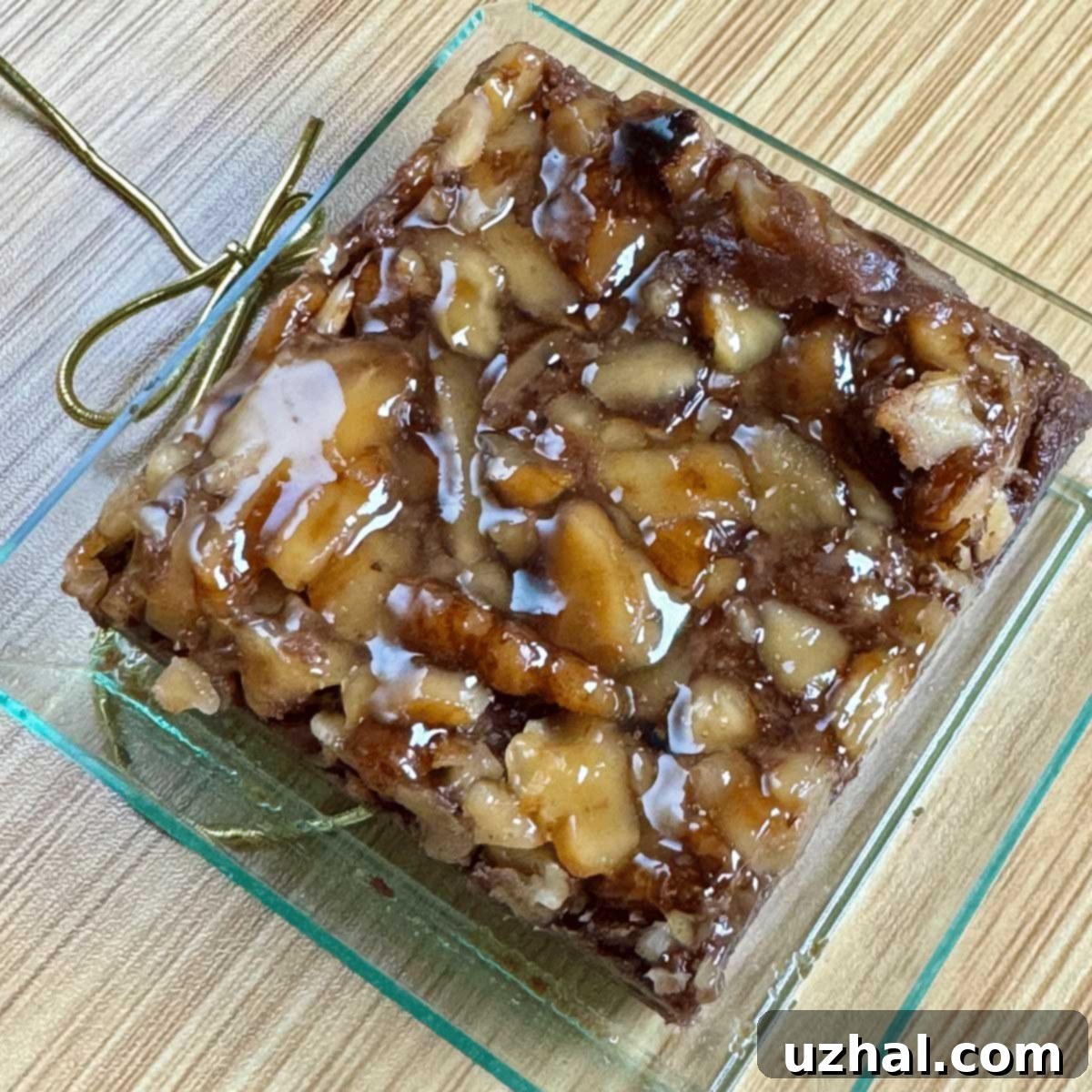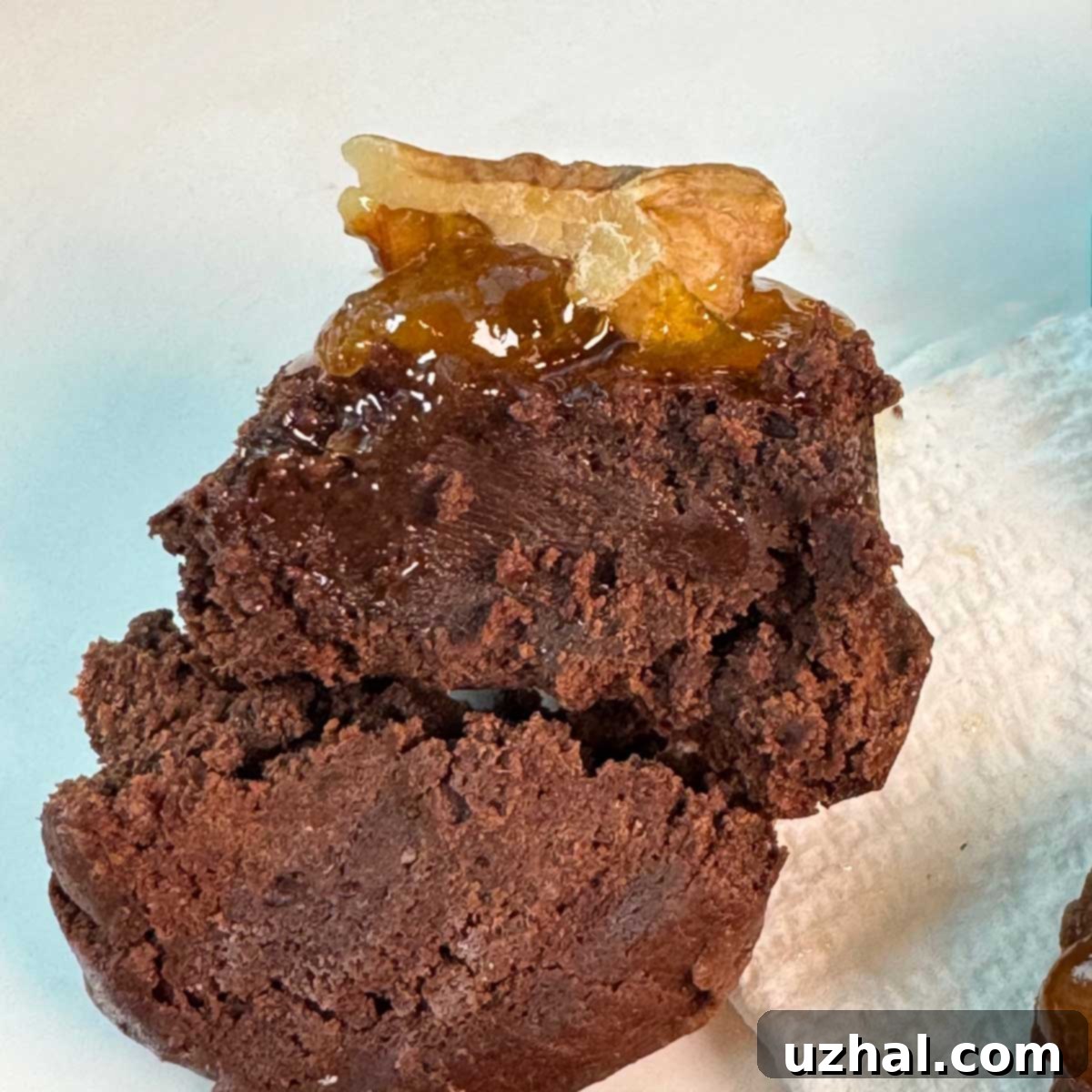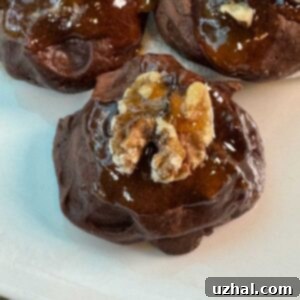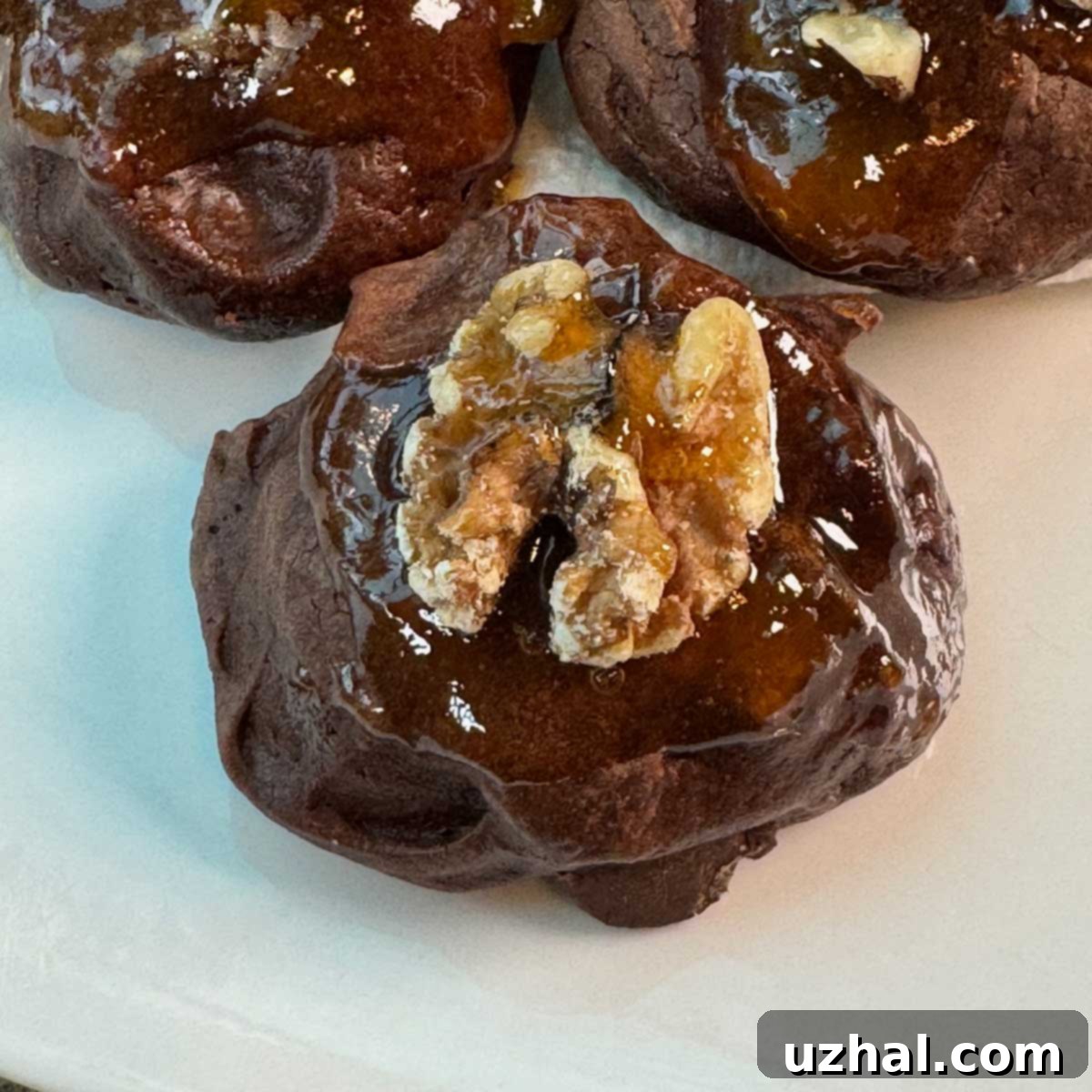Palmer House Brownie Cookies: A Delectable Homage to Chicago’s Historic Treat
Every truly exceptional dish is often accompanied by an intriguing origin story, and for those who appreciate both culinary history and the irresistible comfort of a perfectly baked cookie, this recipe delivers on both fronts. These Palmer House Brownie Cookies are more than just a sweet treat; they represent a playful, bite-sized tribute to one of America’s most iconic baked goods. They pay homage to the legendary brownies first created in 1893 at Chicago’s renowned Palmer House Hotel, specifically for the grand World’s Columbian Exposition. This innovative adaptation transforms the classic fudgy square into a chewy, decadent cookie, meticulously retaining the signature flavors while incorporating a touch of modern baking ingenuity, including a surprising secret ingredient that ensures unparalleled tenderness and a distinct glossy finish.

While the very early origins of “fudge brownies” might still be debated among culinary historians, with various claims surfacing before the turn of the 20th century, the role of the Palmer House Hotel in popularizing this beloved dessert is firmly established. The creation of these famous hotel brownies was a direct commission by Bertha Palmer, a prominent Chicago socialite, philanthropist, and wife of the hotel magnate Potter Palmer. As the hostess for the World’s Columbian Exposition in Chicago, Mrs. Palmer desired a unique, portable chocolate dessert. She envisioned a treat that was sophisticated enough for the thousands of ladies attending the World’s Fair, yet practical and easy to enjoy without the need for traditional silverware or a formal setting. The talented pastry chef at the Palmer House rose to this challenge, inventing a dense, exceptionally fudgy chocolate square. What truly made this creation legendary, and cemented its place in American dessert lore, was its distinctive topping: a glistening apricot glaze complemented by crunchy walnuts. The original Palmer House Brownie became an instant sensation, symbolizing both Chicago’s culinary prowess and the spirit of innovation at the World’s Fair. Over a century later, the Palmer House Hilton proudly continues to sell these authentic brownies, packaged with the same traditional charm. For those eager to taste a piece of history, they are conveniently available for purchase online through platforms like Goldbelly.

Crafting the Palmer House Brownie Cookies: A Modern Interpretation
In a delightful homage to their legendary origin, our Palmer House Brownie Cookies ingeniously capture the very essence of the original dessert while presenting it in a wonderfully new, convenient form. These are far from ordinary chocolate cookies; they are specifically designed to be deep, double chocolate fudge brownie cookies. This means they deliver the intense, melt-in-your-mouth fudginess characteristic of a perfect brownie, but in a compact, handheld format that’s ideal for sharing or personal indulgence. The “double chocolate” aspect ensures a profound and complex flavor profile, achieved through a careful combination of high-quality baking chocolate melted into the batter, supplemented by additional chocolate chips folded in to create pockets of molten deliciousness.
The crowning touch, mirroring the distinction of the original Palmer House Brownie, is the thin, shimmering topping of apricot jam and walnuts. This combination is absolutely essential, providing a vibrant counterpoint of tart fruitiness that beautifully cuts through the profound sweetness and richness of the chocolate. During the development of this recipe, I spent considerable time perfecting the incorporation of the walnuts. The initial question was whether chopped walnuts suspended directly within the apricot preserves would retain their ideal texture and visual appeal, or if a single, more prominent walnut half on top would offer a superior elegant presentation and a more satisfying crunch. After thoughtful experimentation, I embraced both approaches. You’ll find some of these delightful cookies featuring finely chopped walnuts artfully mingled within the apricot jam, while others proudly display a single, perfectly placed walnut half, adding an extra layer of visual charm and a delightful textural surprise with every bite. The ultimate goal was to ensure that the unmistakable apricot and walnut notes, integral to Mrs. Palmer’s original vision, were perfectly present in every single cookie.

The Secret Ingredient: Vodka for Unrivaled Texture and Gloss
Now, let’s address an ingredient that might initially seem unconventional in a dessert recipe: vodka. Rest assured, this seemingly surprising addition plays a scientifically significant role in achieving the extraordinary texture of these brownie cookies. The original brownie cookie recipe that first sparked the inspiration for this creation, a brilliant concept attributed to Claudia Fleming, actually called for a small amount of brewed espresso. While espresso is known to enhance the depth of chocolate flavor, I chose to substitute it with ice-cold vodka, and the results proved to be truly remarkable and uniquely beneficial.
Unlike water or other common liquid components in baking, vodka possesses a unique property: it does not activate gluten. Gluten development is the protein network responsible for giving baked goods their structure and chewiness. By minimizing gluten activation, the alcohol in the vodka ensures that these cookies remain incredibly tender, moist, and delightfully fudgy, preventing them from developing an undesirable dry or cakey texture. Furthermore, pure vodka adds no discernible flavor to the final product. Its alcohol content evaporates entirely during the baking process, leaving behind only its magical textural contributions. An additional, highly desirable benefit of incorporating vodka is its role in the aesthetic of the cookies: it significantly contributes to the formation of that coveted glossy, slightly crinkled “skin” on top, a hallmark of a truly premium brownie. Lastly, the presence of vodka helps to maintain a slightly looser batter consistency, which makes it much easier to spoon and portion accurately onto your baking sheets, thus ensuring uniform cookie size and even baking.

Apricot Glaze: The Signature Palmer House Touch
The apricot and walnut glaze is far more than a mere embellishment; it is, in essence, the very soul of the Palmer House brownie and, by extension, our Palmer House Brownie Cookies. This distinctive topping, which dates back to 1893, is what truly sets these historic treats apart from other chocolate desserts. For our cookie rendition, I’ve refined the glaze to be delicately thin and luminous, ensuring it perfectly complements rather than overwhelms the rich chocolate base. This refined texture is achieved by mixing a tiny amount of softened gelatin with high-quality apricot preserves, then carefully spooning this glistening mixture over each cooled cookie.
The tart sweetness of the apricot creates a magnificent symphony of flavors when paired with the deep, complex notes of the double chocolate. The bright acidity of the fruit brilliantly cuts through the richness of the fudgy chocolate, resulting in a perfectly balanced and harmonious taste experience, precisely as intended in Bertha Palmer’s original vision. The careful addition of gelatin, which is entirely optional if you prefer a less structured glaze, is crucial for achieving a beautifully set, slightly firm yet yielding topping. This ensures the glaze remains neatly in place, giving the cookies a polished, professional appearance. You have complete creative control over the amount of glaze applied; feel free to go as heavy or as light as your personal preference dictates. And for those who may not be particularly fond of apricots, there’s no need to despair! Raspberry preserves would serve as an absolutely fantastic alternative, offering a similar delightful tart-sweet contrast that pairs wonderfully with chocolate. Even a delicate orange marmalade could introduce a lovely citrusy twist, demonstrating the versatility of this iconic topping.

Tips for Achieving Palmer House Perfection in Every Bite
While these Palmer House Brownie Cookies are relatively straightforward to prepare, adhering to a few fundamental guidelines will consistently yield outstanding results. Baking is often a precise art and science, and successful outcomes frequently hinge on meticulous attention to instructions and the thoughtful selection of ingredients. Here are my essential tips for success, designed to ensure your homemade Palmer House Brownie Cookies are as delicious, authentic, and impressive as possible:
- Choose Your Chocolate Wisely for Optimal Flavor and Texture: This ingredient is arguably the most critical component of a truly excellent brownie cookie. Always opt for high-quality chocolate with approximately 70% cacao content. This specific percentage strikes the perfect balance, delivering a profound chocolate flavor without becoming overly sweet or excessively bitter. It’s crucial to steer clear of standard “Toll House” style chocolate chips or similar compound chocolates. While these are perfectly suitable for many other recipes, their higher sugar content, different fat composition, and distinct melting properties can result in a less fudgy, drier, or even slightly greasy cookie in this particular application. For the absolute best texture and deepest flavor, I highly recommend using chopped 72% chocolate bars (or even higher quality couverture chocolate) rather than baking chips, even premium ones like Guittard Sante. Chopped bar chocolate melts more smoothly and incorporates more uniformly into the batter, which is key to achieving that luxurious, consistently fudgy consistency throughout the cookie.
- Batter Consistency is a Crucial Indicator: The initial batter for these cookies possesses a unique consistency. It should start out slightly thin immediately after mixing, but it will noticeably thicken as it rests. The ideal consistency, just before you begin scooping, should be thick enough to hold distinct mounds on your baking sheet, which is essential for preventing excessive spreading during baking. If, after resting, your batter still appears too runny, a brief period of refrigeration (typically 10-15 minutes) can help it firm up to the perfect scooping consistency.
- Never Overbake – The Key to Fudginess: This instruction cannot be emphasized enough. Overbaking is the single fastest way to transform a wonderfully fudgy brownie cookie into a disappointing dry, cakey texture. Aim for a precise baking time of 8 to 9 minutes, as a maximum. The cookies should appear slightly puffed and developed distinct cracks around their edges, but the centers should still look visibly soft and slightly gooey. Remember, they will continue to set and firm up significantly as they cool on the hot parchment paper. Once baked, immediately slide the parchment paper off the hot baking sheet and onto a cool countertop. Allow the cookies to cool and set on the parchment for several minutes before gently transferring them to a wire rack to finish cooling completely. Trust your instincts and the visual cues; it’s better to slightly underbake than overbake.
- Always Toast Your Walnuts for Enhanced Flavor: This seemingly minor step makes a dramatic difference in the overall flavor profile of these cookies. Toasting walnuts actively brings out their natural oils, significantly deepens their nutty flavor, and enhances their satisfying crunch. You can easily toast them in a dry skillet over medium heat for a few minutes, stirring frequently to prevent burning, or by spreading them in a single layer on a baking sheet and baking them in a preheated oven (around 350°F / 175°C) for approximately 5-7 minutes, until they become fragrant and lightly golden. Be sure to let them cool completely before chopping and incorporating them into the glaze or placing them on top of the cookies.
- Allow Sufficient Time for the Apricot Glaze to Set Properly: Patience truly is a virtue in baking, especially when working with glazes. For the most appealing presentation and ideal texture, the apricot glaze requires adequate time to fully set. I strongly recommend refrigerating the topped cookies for at least an hour. This chilling period allows the gelatin to fully activate and the glaze to firm up beautifully, ensuring it doesn’t run or smudge. To ensure optimal flavor and a delightful texture when serving, always remember to bring the cookies back to room temperature before enjoying them. This allows the chocolate to soften slightly to its ideal fudgy consistency and for all the intricate flavors to fully meld and shine.
Explore More Cookie Madness Recipes and Baking Inspiration
If you’ve enjoyed this historical and delicious journey with our Palmer House Brownie Cookies, we invite you to explore more delightful creations and baking insights from our collection:
- Palmer House Brownies (Original Style) – For those curious about the classic, un-modified Palmer House brownie, delve deeper into its rich history and recipe.
- White Chip & Vodka Cookies – Discover other surprising and effective uses for vodka in your baking, yielding similarly tender and delicious results.
- Best Yet Pumpkin Pie – James – A timeless, comforting dessert perfect for any festive occasion or a cozy evening at home.
- Key Lime Pie Coconut Milk Ice Cream – A refreshing, tropical, and dairy-free treat that captures the vibrant flavors of key lime pie.
- Jumbo 3 Chip Cookies – For the ultimate indulgence, experience these generously sized cookies packed with three different kinds of chocolate chips.
Recipe: Palmer House Brownie Cookies

Palmer House Brownie Cookies
Anna
Pin Recipe
Ingredients
- ¼ cup all-purpose flour (32 grams)
- ¼ teaspoon baking powder
- ⅛ teaspoon salt
- 2 large eggs
- ⅔ cup sugar (130 grams)
- ½ tablespoon ice cold vodka
- 1 teaspoon vanilla extract
- 2 tablespoons unsalted butter (28 grams)
- 5 ounces 72% chocolate or Guittard Sante baking chips (140 grams)
- 2 ounces unsweetened chocolate, chopped (56 grams)
- ¾ cup good quality chocolate chips
Apricot Glaze & Walnuts
- 2 teaspoons water
- ¼ teaspoon gelatin
- ¼ cup apricot preserves
- ⅓ cup chopped toasted walnuts or pieces
Instructions
-
Preheat your oven to 350°F (175°C). Prepare two standard baking sheets by lining them with parchment paper, which will prevent sticking and ensure easy cleanup.
-
In a small, separate bowl, whisk together the all-purpose flour, baking powder, and salt until they are thoroughly combined. This ensures even distribution of the leavening agent and seasoning. Set this dry mixture aside.
-
In the bowl of a stand mixer, fitted with the whisk attachment, briefly whisk the two large eggs together. Then, add the sugar to the eggs and beat on high speed until the mixture becomes pale in color, significantly bubbly, and slightly thickened. This process typically takes about 5 minutes, creating a light and airy base. Reduce the mixer speed to low and carefully beat in the ice-cold vodka and vanilla extract until they are just combined, being careful not to overmix.
-
While the eggs and sugar are whipping, combine the unsalted butter and both types of chocolate (the 72% chocolate or Guittard Sante baking chips, and the unsweetened chopped chocolate) in a medium microwave-safe bowl. Melt the chocolate mixture using 50% power in your microwave, stirring thoroughly every 30-40 seconds until it is completely smooth and fully melted. Alternatively, you can melt the chocolate over a double boiler for a more controlled process. Ensure the chocolate is smooth and lump-free.
-
Gently fold the slightly cooled chocolate mixture into the airy egg mixture using a rubber spatula. Mix until it’s about halfway incorporated. At this point, carefully fold in the reserved dry flour mixture until just combined. Be cautious not to overmix, as this can develop gluten and lead to a tougher cookie. Let the batter rest for approximately 5 minutes; this allows it to thicken slightly. Before proceeding, ensure the batter is not too warm (if it is, allow it to cool further), then gently fold in the remaining good quality chocolate chips for extra pockets of melted chocolate.
-
Using a small cookie scoop (about 1.5 tablespoons) or a regular tablespoon, drop uniform mounds of the batter onto the parchment-lined baking sheets, ensuring they are spaced a couple of inches apart to allow for spreading. Bake for 8 to 9 minutes. The cookies are done when they appear slightly puffed, have distinct cracks on their surface, and the edges are set, but their centers still look slightly soft and gooey. Immediately slide the parchment paper, with the cookies still on it, off the hot baking sheet and onto a cool counter. This stops the baking process. Allow the cookies to set on the parchment paper for several minutes before carefully transferring them to a wire rack to finish cooling completely. Remember: do not overbake!
-
While the cookies are cooling, it’s time to prepare the signature apricot glaze that will crown these delicious treats.
-
In a small, heatproof bowl, sprinkle the gelatin evenly over the two teaspoons of water and let it “bloom” (soften) for about 2 minutes. Meanwhile, gently warm the apricot preserves in a small saucepan over very low heat for just a brief moment, simply until they are fluid, then immediately remove from the heat. Add the bloomed gelatin to the warm preserves and stir continuously until the gelatin is completely dissolved and the glaze appears smooth and cohesive.
-
Using a generous ¼ teaspoon measure, carefully spoon the prepared apricot preserves over the center of each completely cooled cookie. If there are any larger chunks of preserves, gently push them to the side or spread them evenly with the back of the spoon for a smooth finish.
-
Immediately sprinkle the toasted chopped walnuts evenly over the preserves on each cookie. Alternatively, for a more aesthetic touch, you can press a single walnut half or quarter onto the glazed surface of each cookie. If you desire an extra glossy finish and to ensure the nuts adhere perfectly, you can spoon a tiny bit more of the apricot preserves directly over the nuts.
-
Transfer the glazed cookies to a plate or clean baking sheet and chill them in the refrigerator for at least one hour, or until the preserves are fully set and firm. For the absolute best flavor and texture experience, allow the cookies to come back to room temperature for about 15-20 minutes before serving. Enjoy your homemade taste of Chicago’s rich culinary history!
